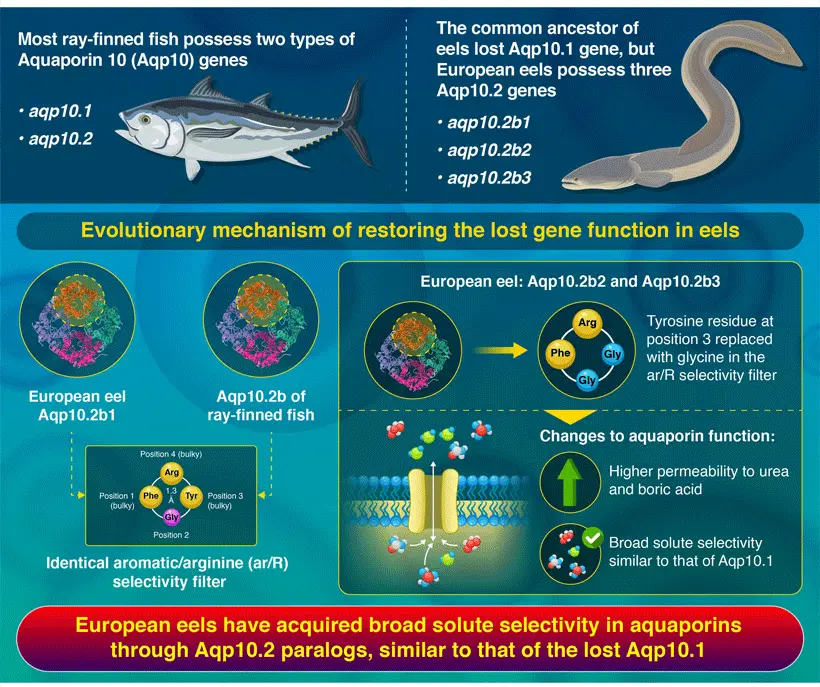Common ancestor eels lost the aquaporin gene encoding proteins with broad solute permeability. Researchers from Institute of Science Tokyo have now found that recent gene duplication events in the European eel (Anguilla species) have restored aquaporin proteins with broad solute permeability. The genes aqp10.2b2 and aqp10.2b3 represent a fascinating example of birth-and-death evolution, in which genes undergo loss of function, duplication, mutation, and functional diversification.
Aquaporin Gene Duplication and Mutation in European Eels

Aquaporin 10 (Aqp10) proteins transport water and uncharged solutes like glycerol across cell membranes, with different types of Aqp10 proteins transporting solutes differently. The common ancestor of ray-finned fishes is known to have possessed two genes for Aqp10-aqp10.1 and aqp10.2. The aqp10.1 gene encodes aquaporins with broad solute permeability, while the aqp10.2 gene encodes proteins with a more restricted permeability. Despite belonging to the family of ray-finned fishes, the common ancestor of eels lost all variants of the aqp10.1 gene during evolution.
Most Anguilliformes species, such as congers and morays, have only one aqp10.2b gene variant. However, during their evolution, European eels acquired three genes of aqp10.2b-aqp10.2b1, aqp10.2b2, and aqp10.2b3. A research team from the Institute of Science Tokyo (Science Tokyo) , Japan, revealed that Aqp10.2b2 and b3 have broad solute permeability similar to Aqp10.1, indicating an interesting example of "birth-and-death evolution." The study was conducted in collaboration with researchers from The University of Tokyo and Shinshu University, Japan, and the findings of this study was published in Volume 17, Issue 10 of the journal Genome Biology and Evolution on September 12, 2025.
The group focused on Anguilla species (eels), which lost aqp10.1 during evolution but acquired multiple copies of Aqp10.2 through tandem gene duplication. "Functional assays using Xenopus oocytes demonstrated that one Aqp10.2 paralog retained narrow solute selectivity, while the other two acquired permeability to urea and boric acid, similar to Aqp10.1. This regained function was traced to a single amino acid substitution in the channel's selectivity filter," explains Nagashima, the lead author of the study.
"The aromatic/arginine (ar/R) selectivity filter is a narrow pore of the aquaporin channel, composed of four amino acids. The ar/R selectivity filter is thought to play a key role in its solute permeability," says Furuta. The researchers found that the European eel Aqp10.2b1 is essentially the same as Aqp10.2b in other fish species. However, in Aqp10.2b2 and Aqp10.2b3, the ar/R selectivity filter has a different amino acid composition. Specifically, the tyrosine (Y) at the third position of the ar/R selectivity filter was mutated to glycine (G).
The aqp10.2b2 and aqp10.2b3 genes represent a fascinating example of birth-and-death evolution, wherein genes undergo loss of function, duplication, mutation, and functional diversification. In the European eel, tandem duplication of aqp10.2 has restored aquaporin permeability to urea and boric acid, which is a functionality that was previously present in their ancestor.
"These findings illustrate how gene duplication followed by mutation can restore ancestral functions, offering new insights into the birth-and-death evolution of aquaporin gene family," notes Kato. The study also highlights the potential of aquaporin gene analysis for understanding physiological adaptation in aquatic vertebrates.
Reference
- Authors:
- Ayumi Nagashima1,2*, Shinichiro Hidaka1,2, Chihiro Ota1,2, Daisuke Yamanaka3,4, Koichi Ito3, Tsutomu Nakada5, Tadaomi Furuta1,2, and Akira Kato1,2*
- Title:
- Loss and Gain of Aqp10 Paralogs with Broad Solute Selectivity in Anguillid Eels
- Journal:
- Genome Biology and Evolution
- DOI:
- 10.1093/gbe/evaf169
- Affiliations:
- 1School of Life Science and Technology, Institute of Science Tokyo, Japan
2School of Life Science and Technology, Tokyo Institute of Technology, Japan
3Department of Food and Physiological Models, Graduate School of Agricultural and Life Sciences, The University of Tokyo, Japan
4Y's Data Science Co., Ltd., Tokyo, Japan
5Division of Instrumental Analysis, Research Center for Advanced Science and Technology, Shinshu University, Japan






